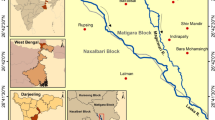Abstract
The paper is devoted to the problems of regulating the hydrological and channel regimes of large navigable rivers, which are currently subject to the anthropogenic influence of engineering factors. Such factors include the construction of retaining hydraulic structures - dams, dredging for the needs of river and sea transport in transit of navigable rivers, free excavation of river alluvium - the production of non-metallic building materials by various subsoil users. Another argument that cannot be ignored today is the climate-related change in the characteristics of river water runoff and alluvium runoff from the territory of the river basin. In different geographical and climatic situations, the interaction of various influence factors and their possible combinations turned out to be different. The degree of occurring changes in the hydromorphology of river channels was also different. The following should be noted as important: such changes on the rivers turned out to be objectively significant, they can be instrumentally measured using special geodetic and hydrometric instruments, have a one-way irreversible character and affect the economic conditions of various water users at a considerable distance from their location. The scientific interest of this work is limited to the field of river transport and problems of land hydrology. The bulk of the materials of this study was obtained on the basis of their own research on free and regulated rivers used in Russia, in a number of former republics of the USSR and abroad to provide shipping by inland river and coastal navigation.
Access this chapter
Tax calculation will be finalised at checkout
Purchases are for personal use only
Similar content being viewed by others
Notes
- 1.
Order of the Government of the Russian Federation of 02.29.2016 No. 327-r.
References
Van Hulten, M.: Prospects for the development of inland water transport in Europe. GeoJournal 1(2), 7–23 (1977). https://doi.org/10.1007/bf00220117
Gladkov, G.L.: Ensuring the conditions of navigation on inland waterways. J. Transp. Russ. Fed. Sci. Transp. Sea River Transp. 1, 8–14 (2014)
Babiński, H.: Międzynarodowa Droga Wodna E40. Stan i możliwości zagospodarowania, Global Compact w Polsce, Raport Żegluga Śródlądowa – Wisła, Rozdz. II, Bezpieczeństwo ekologiczne, pp. 212–217 (2015)
Gladkov, G.L., Chalov, R.S., Berkovich, K.M.: Gidromorfologiya rusel sudokhodnykh rek: Monografiya. 2nd. Lan’, St. Petersburg (2019)
Gladkov, G.L., Katolikov, V.M., Shurukhin, L.A.: Construction of low-pressure hydroelectric facilities on navigable rivers. J. Transp. Russ. Fed. 5(78), 39–42 (2018)
Gladkov, G.L., Zhuravlev, M.V., Sokolov, Y.P.: The Content of Inland Waterways. Track Works, 2nd edn. red. Lan’, St. Petersburg (2019)
Chanson, H.: Fundamentals of open channel flows. Environ. Hydraul. Open Channel Flows, 11–34 (2004). https://doi.org/10.1016/b978-075066165-2/50034-5
Aleksyuk, A.I., Belikov, V.V., Borisova, N.M., Fedorova, T.A.: Numerical modeling of non-uniform sediment transport in river channels. Water Resour. 45(1), 11–17 (2018). https://doi.org/10.1134/S0097807818050275
Klaven, A.B., Kopaliani, Z.D.: Experimental Studies and Hydraulic Modeling of River Flows and Channel Processes. Nestor-Historiy, St. Petersburg (2011)
Antropovskii, V.I.: Hydraulic resistance of different-type river channels with manifestations of karst and suffosion processes. Water Resour. 30(6), 650–652 (2003). https://doi.org/10.1023/b:ware.0000007591.55657.09
Sukhodolov, A.N., Nikora, V.I., Katolikov, V.M.: Flow dynamics in alluvial channels: the legacy of Kirill V. Grishanin. J. Hydraul. Res. 49(3), 285–292 (2011). https://doi.org/10.1080/00221686.2011.567760
Stewart, M.T., Cameron, S.M., Nikora, V.I., Zampiron, A., Marusic, I.: Hydraulic resistance in open-channel flows over self-affine rough beds. J. Hydraul. Res. 57(2), 183–196 (2019). https://doi.org/10.1080/00221686.2018.1473296
Gladkov, G.L., Zhuravlev. M.V.: Hydraulic resistance to water flow and sediment transport in rivers. Vestnik Gosudarstvennogo universiteta morskogo i rechnogo flota imeni admirala S. O. Makarova 11(6), 1044–1055 (2019). https://doi.org/10.21821/2309-5180-2019-11-6-1044-1055
Rijn, V., Leo, C.: Sediment transport, part 1: bed load transport. J. Hydraul. Eng. 110(10), 1431–1456 (1984). https://doi.org/10.1061/(ASCE)0733-9429(1984)110:10(1431)
Ribberink, J.S.: Mathematical modelling of one dimensional morphological changes in rivers with non-uniform sediment. Delft University of Technology, Report 87(2) (1987)
Söhngen, B., Kellermann, J., Loy, G.: Modelling of the Danube and Isar Rivers morphological evolution. Part I: Measurements and formulation. In: Proceedings of 5th International Symposium On River Sedimentation, Karlsruhe, vol. 3, pp. 1175–1207 (1992)
Collis-George, N., Youngs, E.G.: Some factors determining water-table heights in drained homogeneous soils. J. Soil Sci. 9(2), 332–338 (1958)
Meyer-Peter, E., Muller, R.: Formulas for bed-load transport. In: Proceedings of 2nd Meeting of the International Association for Hydraulic Structures Research, pp. 39-64. Delft (1948)
Shields, A.: Anwendung der Ahnlichkeitsmechanik und der Turbulenzforschung auf die Geschiebe Bewegung. Diss, Berlin (1936)
Yang, S.-Q.: Sediment transport capacity in rivers. J. Hydraul. Res. 43(2), 131–138 (2005). https://doi.org/10.1080/00221686.2005.9641229
Hasegawa, K., Hirose, K., Meguro, E.: Experiments and analysis on alternating mainstream change in the bifurcated channel in mountain rivers. Proc. Hydraul. Eng. 47, 679–684 (2003). https://doi.org/10.2208/prohe.47.679
Author information
Authors and Affiliations
Corresponding author
Editor information
Editors and Affiliations
Rights and permissions
Copyright information
© 2021 The Editor(s) (if applicable) and The Author(s), under exclusive license to Springer Nature Switzerland AG
About this paper
Cite this paper
Gladkov, G., Zhuravlev, M., Katolikov, V. (2021). Hydromorphological Substantiation of Channel Stability of Navigable Rivers in Engineering Water Transport Regulation of River Runoff. In: Murgul, V., Pukhkal, V. (eds) International Scientific Conference Energy Management of Municipal Facilities and Sustainable Energy Technologies EMMFT 2019. EMMFT 2019. Advances in Intelligent Systems and Computing, vol 1259. Springer, Cham. https://doi.org/10.1007/978-3-030-57453-6_63
Download citation
DOI: https://doi.org/10.1007/978-3-030-57453-6_63
Published:
Publisher Name: Springer, Cham
Print ISBN: 978-3-030-57452-9
Online ISBN: 978-3-030-57453-6
eBook Packages: Intelligent Technologies and RoboticsIntelligent Technologies and Robotics (R0)




